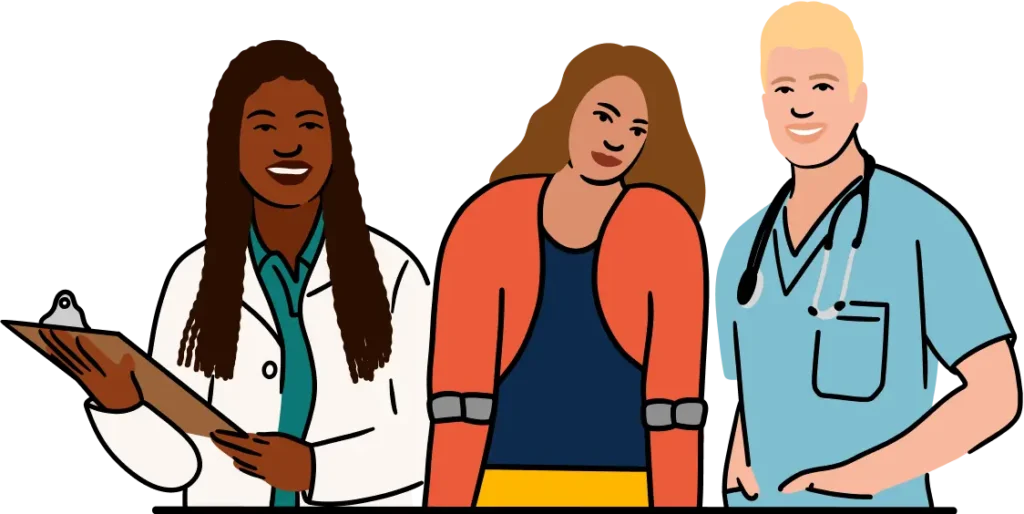Changing How Healthcare is Paid For
Making IDD Visible
A multi-year project to use artificial intelligence (AI) and support people with intellectual and/or developmental disabilities (IDD) by better identifying them in clinical and claim data, addressing disparities, and building a more supportive and effective healthcare system.
Changing How Healthcare Data is Used to Pay for the Right Services
IEC knows that better data is a critical first step to improving lives for people with IDD – it will unlock accurate knowledge about the population, help them access the right services, and prevent bad clinical decisions. Making IDD Visible recognizes the urgency of developing e-IDD, an AI tool that will help identify children and adults who are likely to have IDD, by analyzing clinical and billing data.
We will build e-IDD using data on over 1,000 patients, leveraging lived expertise of people with IDD, clinicians, data scientists, and data ethicists. Usable by clinicians, payers, government, researchers, and other organizations that adhere to rules for appropriate, safe, ethical, and respectful applications, the tool will empower people with IDD, support more respectful conversations between clinicians and patients, and help reduce inequities in healthcare.
- 1 in 20 Americans have IDD
- 10x: the order of magnitude by which people with IDD are undercounted in insurance claims and electronic medical records
- 1 in 4 people with a disability do not have a regular healthcare provider
- $350 billion: annual cost of care spent on the wrong services that don’t improve people’s health
Why This Matters
You can’t serve someone invisible to you. Currently, many people with IDD are inadequately identified in standard healthcare data. Surveys and CDC data suggest that the true prevalence of IDD could be around 20 times higher than what insurance claims and electronic medical records currently show (30-50 people per 1,000 with IDD versus one to three people per 1,000).
These data gaps have far-reaching impacts, denying people with IDD the resources they need to thrive, leading clinicians and insurers to make wrong decisions that can lead to harm, and healthcare leaders as a whole falsely believing that the IDD population is small and their needs are a “niche” problem. Reasons for this invisibility include: doctors not checking for or diagnosing IDD enough, people with IDD not mentioning their diagnosis because of real and perceived negative consequences, and medical records not traveling with a patient, especially as they become adults.
People with IDD deserve to be seen, heard, and supported. Making IDD Visible will accelerate efforts to address disparities in access and quality of care that people with IDD face. It will enable better measurement of health outcomes that matter to people with IDD, as well as create a true understanding of how healthcare is utilized. Effectively targeting services and identifying trends in spending will pave the way for critical investments in high-quality, empathetic care that meets the unique needs of people with IDD.
Making IDD Visible Highlights
2022
Established a committed core team including Duke University, Montefiore Medical Center, Intel, Nationwide Children’s Medical Center, and Jefferson Health.
2023
Added advisor and IDD self-advocates to core team. Completed detailed code list for International Classification of Diseases, 10th edition (ICD-10), defining the IDD population in collaboration with people with lived experience of autism and intellectual disabilities and clinicians experienced in working with autistic children and/or adults and those with intellectual disabilities. Conducted preliminary analyses in electronic health record data.
Phase 2 (TBD)
Completed a claims analysis in private insurance claims data with Milliman. Designed an approach to create descriptions of how people with IDD may appear in data, identify sources of possible data bias, and address ethical issues in how e-IDD should be built and used.
Making IDD Visible Partners
Making IDD Visible is a diverse coalition that includes people with IDD, clinicians, researchers, and other healthcare leaders. The project group operates collaboratively, based on the principles of Authentic Community Engagement – learning from the lived experience of people from IDD and the perspectives of healthcare professionals to create commonsense solutions.
Click on each to expand
Project Lead
- Mai Pham, President and CEO, IEC
Partners
- Duke University
- Epic
- Jefferson Health
- Montefiore Medical Center
- Nationwide Children’s Hospital
- Self-Advocates
Team on Insurance Claims Analysis
- Harsha Mirchandani
- Pamela Pelizzari
- Ian Moura
- Jennifer Kucera
- Gary Maslow
- Michelle Franklin
Making Healthcare Better and Safer for People with IDD
IEC partners with people with lived experience of IDD and healthcare professionals to change the way care is taught, delivered, and paid for by creating new programs that center patients.




